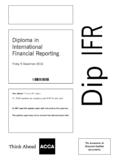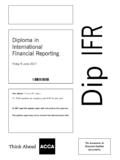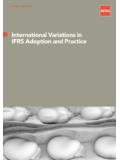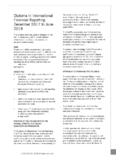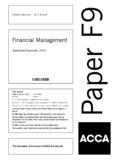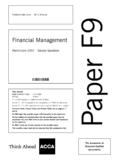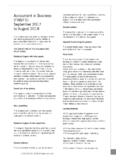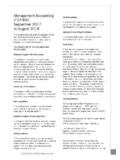Transcription of Business and Technology (BT/FBT)
1 Business and Technology (BT/FBT) ACCA 2020-2021 All rights reserved. Business and Technology (BT/FBT) Syllabus and study guide September 2020 to August 2021 Designed to help with planning study and to provide detailed information on what could be assessed in any examination session Business and Technology (BT/FBT) ACCA 2020-2021 All rights reserved. Summary of content Introduction 1. Intellectual levels 2. Learning hours and educational recognition 3. Qualification Structure 4. Guide to ACCA examination structure and delivery mode 5. Guide to ACCA examination assessment Business and Technology syllabus 6. Relational diagram linking Business and Technology with other exams 7.
2 Approach to examining the syllabus 8. Overall aim of the syllabus 9. Introduction to the syllabus 10. Main capabilities 11. The syllabus Business and Technology study guide 12. Detailed study guide 13. Summary of changes to Business and Technology (BT/FBT) Business and Technology (BT/FBT) ACCA 2020-2021 All rights reserved. levels ACCA qualifications are designed to progressively broaden and deepen the knowledge and skills demonstrated by the student at a range of levels on their way through each qualification. Throughout, the study guides assess both knowledge and skills. Therefore, a clear distinction is drawn, within each subject area, between assessing knowledge and skills and in assessing their application within an accounting or Business context.
3 The assessment of knowledge is denoted by a superscript K and the assessment of skills is denoted by the superscript S. hours and education recognition As a member of the International Federation of Accountants, ACCA seeks to enhance the education recognition of its qualification on both national and international education frameworks, and with educational authorities and partners globally. In doing so, ACCA aims to ensure that its qualifications are recognised and valued by governments and regulatory authorities and employers across all sectors. To this end, ACCA qualifications are currently recognised on the educational frameworks in several countries. Please refer to your national education framework regulator for further information about recognition.
4 Structure The qualification structure requires candidates who wish to be awarded the ACCA Diploma in Accounting and Business (RQF Level 4) to pass the Business and Technology (BT)/FBT, Management Accounting (MA) /FMA and the Financial Accounting (FA)/FFA examinations and successfully complete the Foundations in Professionalism (FiP) module. Business and Technology (BT/FBT) ACCA 2020-2021 All rights reserved. to ACCA examination structure and delivery mode The structure of examinations varies. The Foundations examinations contain 100% compulsory questions to encourage candidates to study across the breadth of each syllabus. All Foundations examinations are assessed by two-hour computer based examinations.
5 The pass mark for all FIA examinations is 50%. to ACCA examination assessment ACCA reserves the right to examine anything contained within any study guide within any examination session. This includes knowledge, techniques, principles, theories, and concepts as specified. For specified financial accounting, audit and tax examinations, except where indicated otherwise, ACCA will publish examinable documents once a year to indicate exactly what regulations and legislation could potentially be assessed within identified examination sessions. For this examination regulation issued or legislation passed on or before 31st August annually, will be assessed from September 1st of the following year to August 31st of the year after.
6 Please refer to the examinable documents for the exam (where relevant) for further information. Regulation issued or legislation passed in accordance with the above dates may be examinable even if the effective date is in the future. The term issued or passed relates to when regulation or legislation has been formally approved. The term effective relates to when regulation or legislation must be applied to entity transactions and Business practices. The study guide offers more detailed guidance on the depth and level at which the examinable documents will be examined. The study guide should therefore be read in conjunction with the examinable documents list. Business and Technology (BT/FBT) ACCA 2020-2021 All rights reserved.
7 Diagram linking Business and Technology (BT/FBT) with other examsThe Foundations in Accountancy suite of qualifications is designed so that a student can progress through three discrete levels; RQF Level 2, 3, and 4. Students are recommended to enter Foundations in Accountancy at the level which is most appropriate to their needs and to take examinations in order, but this is not a mandatory requirement. to examining the syllabus The syllabus is assessed by a two hour computer-based examination. Questions will assess all parts of the syllabus and will test knowledge and some comprehension or application of this knowledge. The examination will consist of two sections. Section A will contain 30 two mark objective questions and 16 one mark objective questions.
8 Section B will contain 6 four mark multi-task questions each of which will examine one of the six main sections of the syllabus. aim of the syllabus To introduce knowledge and understanding of the Business and its environment and the influence this has on how organisations are structured and on the role of the accounting and other key Business functions in contributing to the efficient, effective and ethical management and development of an organisation and its people and their interaction with Technology , data and information systems. Business and Technology (BT/FBT) ACCA 2020-2021 All rights reserved. to the syllabus The Business and Technology (BT/FBT) syllabus introduces students who may not have a Business background, to the Business , which as an entity is made up of people and systems which interact with the environment and with each other.
9 The syllabus begins with examining the purpose and types of Business which exist, the key stakeholders and the rights and responsibilities that businesses have in connection with them, exploring the external influences that affect the Business in its environment, including economic, legal, social and technological factors. The syllabus then examines the structure and functions of Business , focusing on corporate governance and the specific accounting related roles in this process, particularly in financial reporting, assurance, control and compliance. The syllabus then introduces key leadership, management and people issues such as effective individual and team behaviour, motivation and personal effectiveness.
10 The final section of the syllabus examines how behaviour at all levels within Business should be underpinned by accepted professional ethics and professional values. Business and Technology (BT/FBT) ACCA 2020-2021 All rights reserved. capabilities On successful completion of this exam, candidates should be able to: A Understand the purpose and types of businesses and how they interact with key stakeholders and the external environment. B Understand Business organisation structure, functions and the role of corporate C Recognise the functions, systems and new technologies in accountancy and audit in communicating, reporting and assuring financial information, including the effective compliance, internal control and security of financial and other data.

